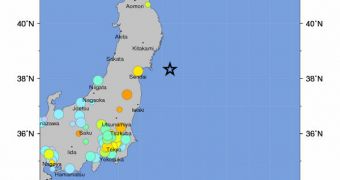Though it's been only a few hours since Japan has been hit by one of the largest earthquakes ever, scientists and Earth sciences experts are already beginning to comment on the scale of the disaster.
Bob Holdsworth, a professor of structural geology in the Department of Earth Sciences at the Durham University, in the United Kingdom, says that this tremor was about 1,000 times more powerful than the quake that struck New Zealand, just a few weeks ago.
According to the expert, it seems that this event was the strongest to affect the Far East since historical records began. This is saying a lot, considering that Japan is often subjected to tremors due to its geographical location.
The islands lie in the “Pacific Ring of Fire,” an area spanning the borders of the Pacific Ocean and includes the West Coast of the United States, Canada and South America, as well as New Zealand.
This area developed due to the fact that the Pacific tectonic plate is being pushed against by all of its neighbors. It is therefore sinking underneath them at very shallow angles, and this oftentimes leads to the plates becoming jams.
As tension builds, the plates eventually snap loose and resume gliding, triggering volcanic eruptions, earthquakes and tsunamis in the process. Geologists say that gliding plates can produce either shallow (tens of kilometers) or deep (hundreds of kilometers) tremors.
The former variety is the most dangerous. The closer the epicenter to the Earth's surface, the more likely huge damages and casualties will ensue. On the bright side, Japan has strict building codes precisely because of its location, and this may contribute to saving many lives.
According to Bob Holdsworth, the 8.9-magnitude tremor that struck 373 kilometers (231 miles) northeast of Tokyo caused tsunamis that may reach as far south as South America and Hawaii.
The epicenter of the “mega” tremor was found to be some 80 miles (128 kilometers) offshore, at a depth of 24.4 kilometers (15.2 miles), which is really shallow.
“Japan is one of the most dangerous seismically active regions in the world and the constant threat of earthquakes and associated hazards such as tsunami has strongly shaped the development of Japanese culture and infrastructure over many hundreds of years,” the Durham expert comments.
“The magnitude of this event is staggering: it is almost a thousand times more powerful that the recent Christchurch earthquake in New Zealand and nearly one hundred times more powerful that the 2010 Haiti earthquake,” he adds.
“It is slightly smaller than the Sumatra earthquake of 2004, a magnitude 9.1 event. These last two events combined killed over 500,000 people,” the expert goes on to say.
“Yet of all the countries in the world it could strike, Japan is amongst the very best prepared. Had this not been the case the effects of this earthquake would have been even more devastating,” he concludes.
Keep an eye on this space for developments as things progress.

 14 DAY TRIAL //
14 DAY TRIAL //